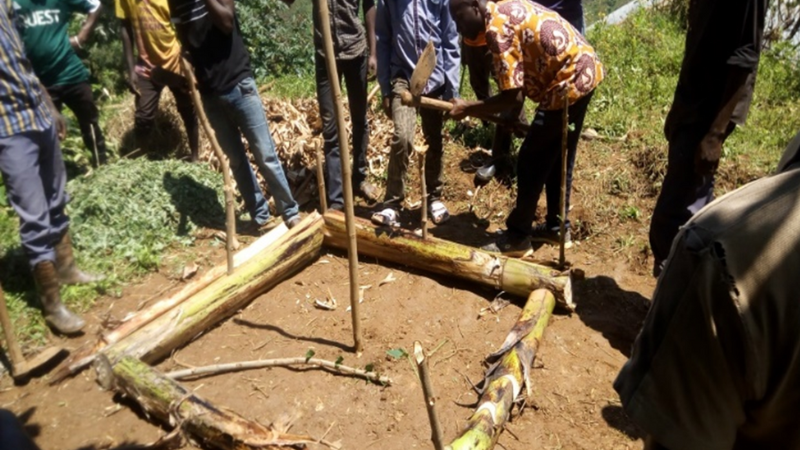by CONAPAC
Description
The effects of climate change are evident in the activities of farmers. Climate change is reflected in rainfall patterns, which affect the agricultural calendar and disrupt farming activities. This results in lower yields and, therefore, lower incomes and keeps farmers in poverty. COVID 19 has affected the agricultural sector disruptively worldwide, with farmers asked to keep working to ensure food security and a burden on the entire food value chain to function properly while facing operational obstacles. Undoubtedly, the pandemic outbreak has coupled with climate challenges, increasing pressure on fragile agricultural systems.
The promotion of sustainable agriculture is part of the climate change adaptation process, consisting of:
- Promote conservation agriculture and the practices developed by UDPKIS: CONAPAC advocates conservation agriculture, which is practiced in particular by UPDKIS in the province of Tshopo, around Kisangani; it consists of the use of no-till farming, and in the forest without felling trees.
- Develop agroforestry, diversify the models starting from the one in Mampu.
- Share the experience of the natural regeneration and land clearing developed by WWF DRC.
- Train farmers in fire prevention and anti-fire brigades; and in firebreaks combining crops.
- Support for community forestry and the agricultural sedentarisation of the families concerned, search for financial means to support this change.
- Develop compost production, crop rotation with leguminous plants, and other organic matter production systems, and extension on these subjects.
- Develop perennial cocoa, coffee, oil palm, and strengthen the value chains of these critical sectors;
- Practice permaculture by some farmers.
- Cultivation of earthworms to use the waste as a sanitary plant protection product for coffee cultivation and as fertilizer.
- Choice of more environmentally friendly products, Abandonment of chemicals in favour of biological (e.g., biocontrol) or mechanical methods, less impact on the environment, Self-regulation of pathogens by the unrestored agro-ecosystem.
- Soil protection and conservation practices in the fields by terracing along the contour farming measured by the “A-triangle,” reducing the speed of run-off water by diverting it to the field, improving the ridging system which is more pronounced with row seeding, ridging, judicious choice of cover crops, ploughing against the slope.
- Vermicompost, like conventional compost, has many benefits for agricultural soils, including increasing their ability to retain moisture and nutrients, improving their structure, and providing higher levels of microbial activity.
Results
The use of better agroecological practices has led to increased yields of agricultural products, increasing farmers’ income. Additionally, these sustainable practices have positively influenced agricultural production with high output. For example, in Goma, potatoes increased from 1 bag for 2 to 3 bags before these good practices and from 1 bag to 6 to 9 bags afterward.
Climate smartness*
There are several elements in this case that positively impact Climate-smart pillars. In addition to the abovementioned benefits on yield and income from implementing diverse CSA practices, it is important to highlight the diversification of the production systems that not only contribute to the yield increase found, but also allows farmers to better adapt to changing climate and market conditions by having a wider range of tradable products. In this vein, integrate a value chain approach also helps to improve farmers’ livelihoods, for example, the progressive substitution of synthetic agrochemicals by local production and use of compost and vermicompost, represent both socio-economic and environmental advantages. These organic options often represent profitable sources of nutrients for crops while reduces the carbon footprint from manufacturing, transport, application and disposal of synthetic compounds. These alternatives, in combination with woody species within agroforestry systems are also beneficial for the biological activity of the soil that results in its short- to long-term health and therefore its ability to store carbon both in the soil and in aerial biomass. As a complement, contour farming techniques minimize soil erosion. Conservation agriculture and permaculture are also relevant to integrate additional crop management practices and approaches that allow producers and consumers to understand the different elements and interactions that make up the agroecosystem. Favouring the maintenance of various ecosystem services of interest to society, e.g., pollination, regulation of water cycles and provision of food, medicine and raw materials, just to mention a few examples.
*This is done in the framework of climate-smart agriculture (CSA) approach. Climate-smartness in agriculture means understanding impacts of climate change and variability along with the agricultural activity, which includes the planning of what crop to plant, when to plant, what variety to plant and what type of management practices are needed to reduce the impact on the environment (e.g. emissions reduction), maintain or increase productivity (e.g. yields) while increasing resilience and improving livelihoods.


